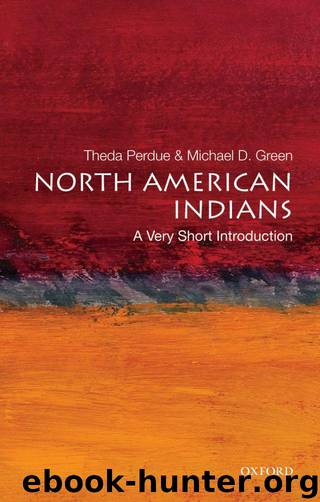North American Indians by Perdue Theda Green Michael D

Author:Perdue, Theda, Green, Michael D. [Perdue, Theda, Green, Michael D.]
Language: eng
Format: mobi, epub
Publisher: Oxford University Press, USA
Published: 2010-01-02T18:30:00+00:00
Chapter 5
Assimilation and allotment
United States Indian affairs contained many contradictions, none quite as apparent as the seemingly antithetical policies of separating Indians on reservations while assimilating them into American society. Separation presumably provided Indians with an opportunity to acquire the skills they needed to assimilate, but the process of preparing Indians for assimilation on reservations seemed excruciatingly slow. By the late nineteenth century, many people had concluded that the time had come to withdraw the special status of Indians as sovereign peoples and incorporate them as individuals into American society.
The United States embarked on an effort to educate Indian children for their integration into the mainstream and adopted policies to force Native peoples to abandon their own cultural traditions. Reformers embraced assimilation because it promised the dissolution of tribes, regarded as vestiges of savagery and primitivism in the modern world. The demise of tribes meant the end of tribally held land, an objective capitalists could support, and the elimination of government expenditures for Indians, an attractive prospect for politicians.
Before the Civil War, missionary societies operated schools among a number of Indian tribes, especially in the East and Midwest, and a few tribes supported their own schools. Following the war, Indian education became a feature of U.S. policy, and treaties provided for the establishment of schools. In 1870 Congress appropriated $100,000 for Indian education, an amount that increased over twenty times in the next two decades but never came close to meeting the needs. Given the paucity of resources and the difficulty of hiring teachers, the Office of Indian Affairs (OIA) often turned to mission societies to run schools. Imbued with religious zeal, missionaries displayed little cultural sensitivity. They conducted classes in English and discouraged any display of traditional culture. Francis La Flesche, an Omaha enrolled in a Presbyterian school in Nebraska in the1860s, recalled that the school master had the boys recite their lesson for visitors. The first question was, “Who discovered America?” The correct answer was not “Indians.” Children found ways to resist the indoctrination. When the visitors asked students to sing an Indian song, one boy broke out in the Omaha victory song. Others joined in. “We felt, as we sang,” La Flesche remembered, “the patriotic thrill of a victorious people who had vanquished their enemies.” Although they had requested the performance, the visitors snapped, “That’s savage, that’s savage! They must be taught music.”
The names of Indian students posed a problem for their teachers. Most Native people did not have given names and surnames, and a person’s name might change over his or her lifetime. Missionaries, teachers, and government officials found Indian names unpronounceable and translations nonsensical. Therefore, they often named children after famous Americans. La Flesche, whose name came from his French grandfather, attended school with other Omaha children whom missionaries had named Isaac and Abraham as well as George Washington, William T. Sherman, and Ulysses S. Grant. By the 1890s United States superintendents at some agencies had realized that the use of such names “caused the
Download
North American Indians by Perdue Theda Green Michael D.epub
This site does not store any files on its server. We only index and link to content provided by other sites. Please contact the content providers to delete copyright contents if any and email us, we'll remove relevant links or contents immediately.
| African-American Studies | Asian American Studies |
| Disabled | Ethnic Studies |
| Hispanic American Studies | LGBT |
| Minority Studies | Native American Studies |
Cecilia; Or, Memoirs of an Heiress — Volume 1 by Fanny Burney(32433)
Cecilia; Or, Memoirs of an Heiress — Volume 2 by Fanny Burney(31866)
Cecilia; Or, Memoirs of an Heiress — Volume 3 by Fanny Burney(31850)
The Great Music City by Andrea Baker(31319)
We're Going to Need More Wine by Gabrielle Union(18967)
All the Missing Girls by Megan Miranda(15560)
Pimp by Iceberg Slim(14376)
Bombshells: Glamour Girls of a Lifetime by Sullivan Steve(13971)
Talking to Strangers by Malcolm Gladwell(13218)
Norse Mythology by Gaiman Neil(13204)
Fifty Shades Freed by E L James(13157)
For the Love of Europe by Rick Steves(12917)
Mindhunter: Inside the FBI's Elite Serial Crime Unit by John E. Douglas & Mark Olshaker(9186)
Crazy Rich Asians by Kevin Kwan(9164)
The Lost Art of Listening by Michael P. Nichols(7403)
Enlightenment Now: The Case for Reason, Science, Humanism, and Progress by Steven Pinker(7227)
The Four Agreements by Don Miguel Ruiz(6618)
Bad Blood by John Carreyrou(6543)
Weapons of Math Destruction by Cathy O'Neil(6139)
